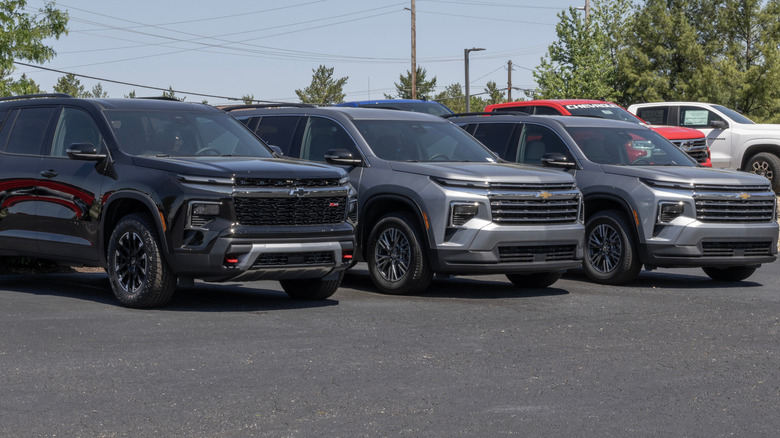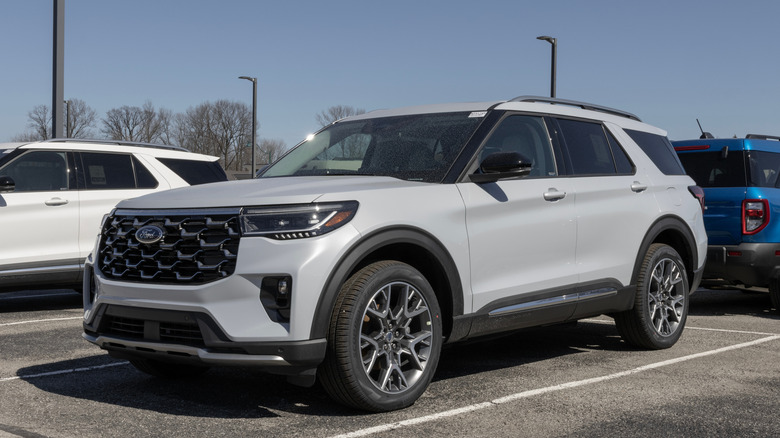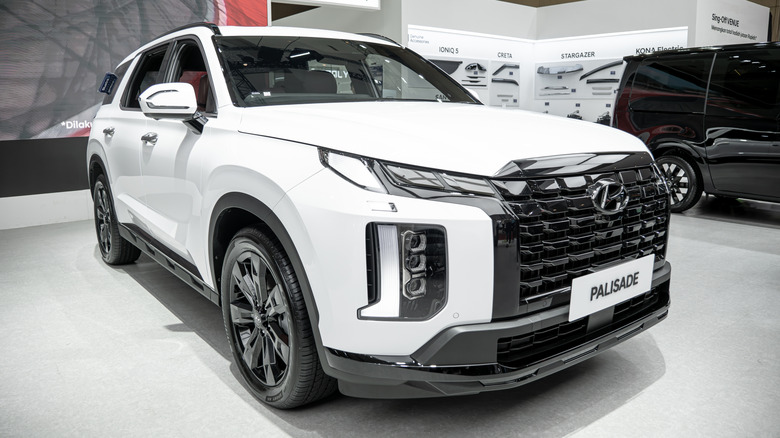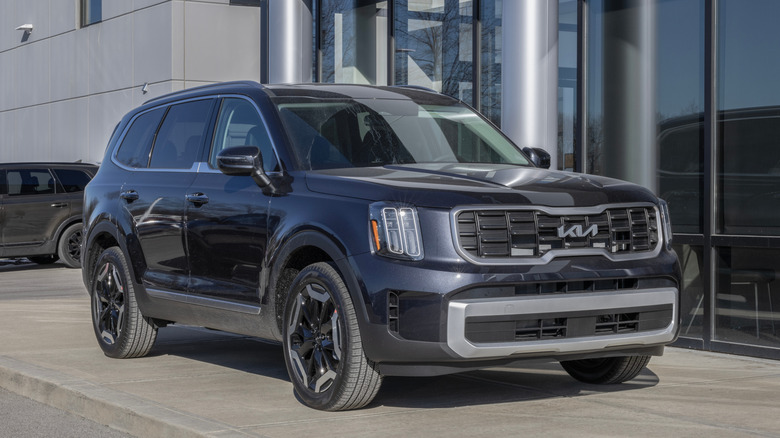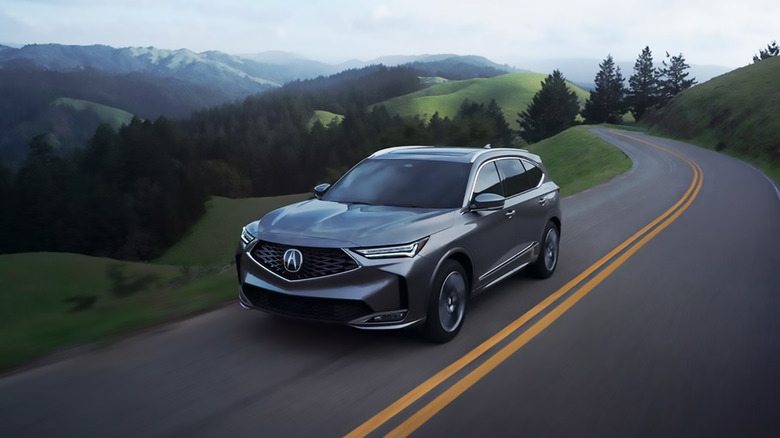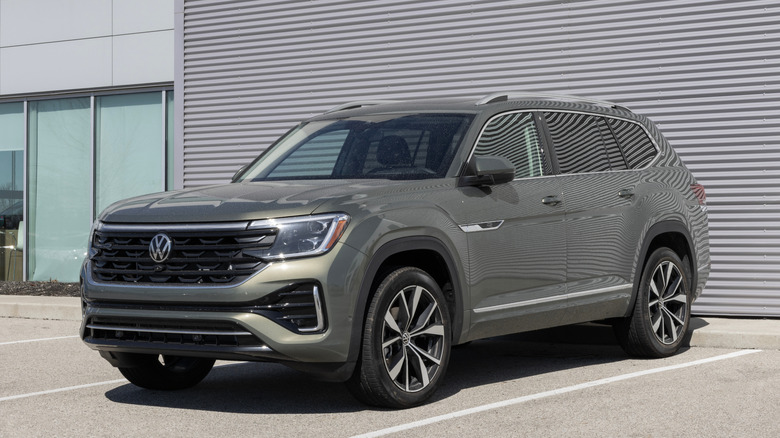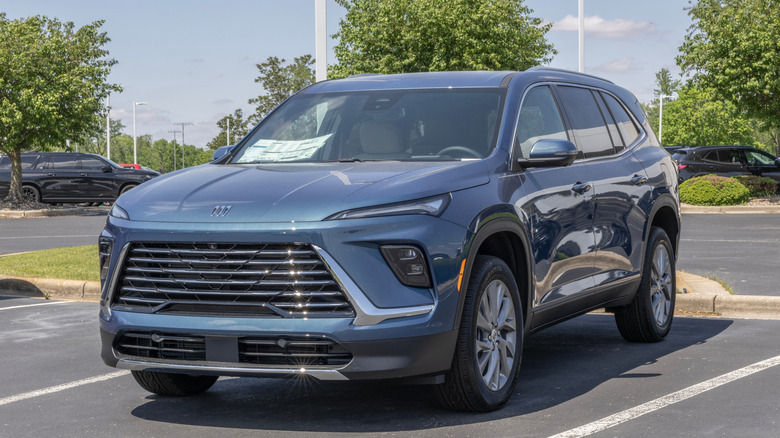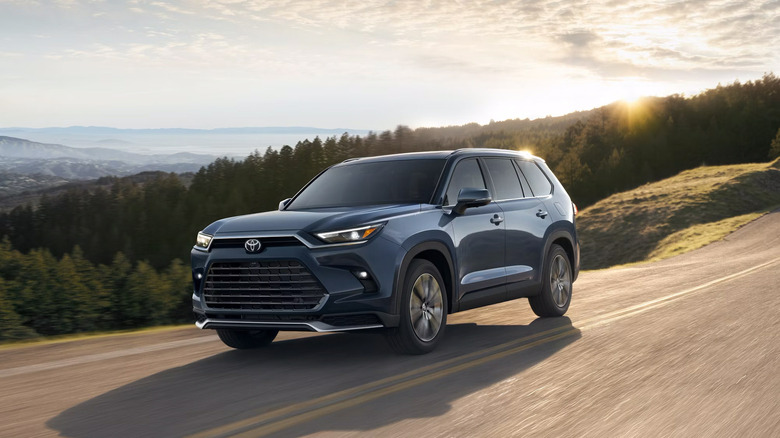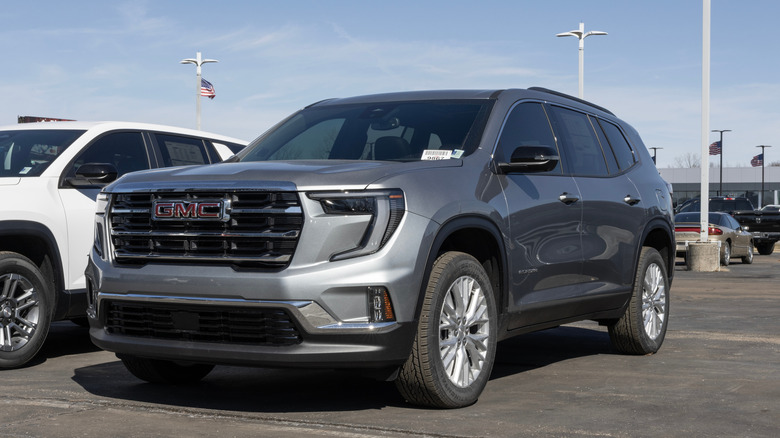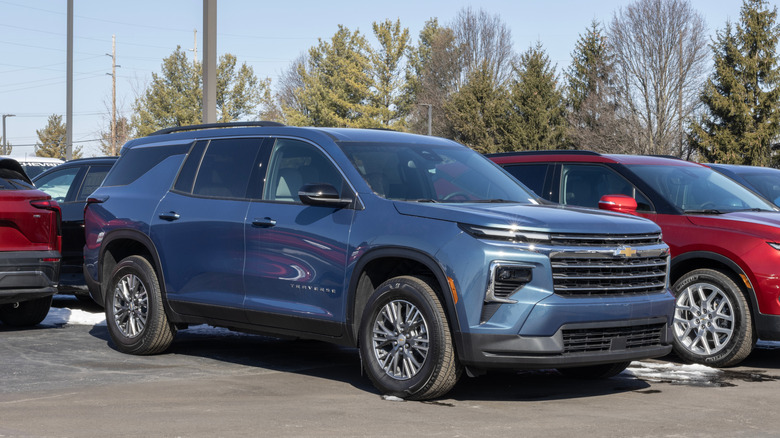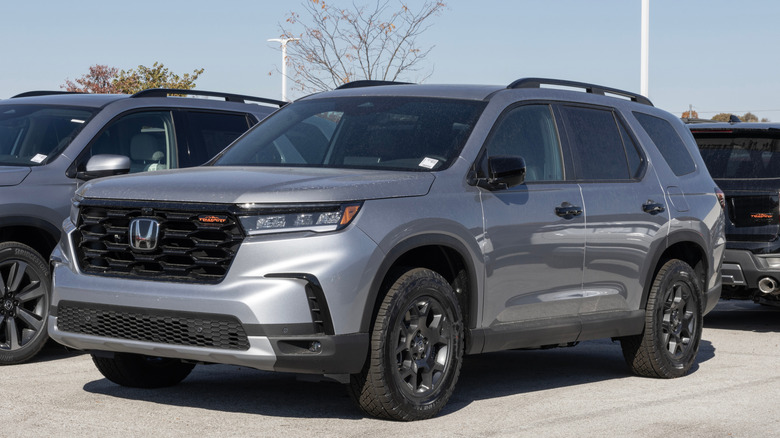10 Mid-Size SUVs With The Most Cargo Room
With endless choices for an SUV in 2025, finding the model that's best for your needs can feel particularly daunting. While it's great that manufacturers are continuing to set new standards in the segment, the differences between the starting price points, size, and powertrain manage to separate each model enough for them to be worthy of consideration. Out of all types of SUVs, the mid-size segment best combines practicality with drivability, which so happens to be one of the more competitive areas of the vehicle type. The compact segment may have the best-selling models like the Toyota RAV4 and Honda CR-V, but opting for a slightly larger model gives you a great road trip car as well as an urban driver.
Mid-size SUVs often come with more power, but the standout selling point is the increased functionality they provide for cargo space. The choice for a third row has become more common in recent years, which not only provides space for at least two more passengers, but the longer chassis helps provide more space behind the first and second rows. Cargo volume is one of the areas that manufacturers try their best to maximize, but different standards of measurement are used by these brands, which make it even more difficult to navigate. To find the mid-size SUVs with the most cargo space for 2025, we took the information provided by the leading manufacturers to compile our list.
2025 Ford Explorer
Regarding the most established American automakers throughout history, very few can come close to Ford. Over the years, Ford has entered almost every segment in the industry, whether that's with the Mustang in the muscle scene or the F-Series pickup truck, remaining one of the most versatile brands on the market. Like its key competitors, the Dearborn-based manufacturer puts a lot of its attention on the SUV segment, offering six models in total across different sizes. Both the Bronco and Explorer compete in the mid-size segment, with the latter being the more practical and adept for everyday driving. As a result, the Ford Explorer offers plenty of space behind all seats, ensuring not fall far behind its rivals.
The 2025 Explorer isn't the most expensive model in the Ford SUV lineup for this year — that title goes to the Expedition at $62,000. The Explorer is the second-most expensive model but comes in significantly below that with an MSRP of $39,785. For the top-spec ST model that we loved reviewing, these trim costs a minimum of $54,240. Looking further back, the 2025 Explorer offers a solid 85.8 cubic feet of cargo room behind the front seats, which decreases to 46 cubic feet behind the second row. This mid-size SUV also comes with a third row of seating as standard, which, when left up, leaves 16.3 cubic feet of cargo space, which is also ultra-competitive among these vehicles.
2025 Hyundai Palisade
A brand that continues to prove itself against international rivals, particularly in the SUV segment, is Hyundai. The Korean brand ensures to tick the majority of the boxes when it comes to SUVs, such as their practicality and usability but goes a step further with design, cabin quality, and standard tech to offer something more unique in the most competitive space in the industry. Hyundai offers three different mid-size SUVs in 2025, with the three-row Palisade being the largest and approaching full-size territory. Despite its size, the Palisade still manages to be competitively priced at $37,200, which is less than multiple other models on this list.
While a fair few of the top-end features for the Palisade are reserved for the top-spec trims, the cargo space remains the same throughout all of them to keep it practical no matter what level you go for. Behind the first row, the Hyundai provides 86.4 cubic feet of space, 45.8 cubic feet behind the second row, and 18 cubic feet behind the third row. Alongside its cargo space, you'll struggle to find another mid-size SUV with a combination of passenger and cargo space, especially when considering its sub-$40,000 price point.
2025 Kia Telluride
Despite the two brands operating independently, many of Kia's vehicles share similarities with its parent company, Hyundai, specifically under their shells. However, from the outside, the two brands take different directions for design styles and come with unique interiors to keep them separate. Kia also offers a wide range of SUVs to appeal to all, with the Telluride essentially being the equivalent of the Palisade. The two share the same platform and 3.6L V6 engine but differ slightly when it comes to their dimensions and starting price.
For the base LX trim, the 2025 Kia Telluride comes in at $36,390, ever-so-slightly undercutting the Palisade. Looking at the interior dimensions, the Kia once again comes out ahead by a hair, with 87 cubic feet of cargo volume behind the front seats. Further back, you get 46 cubic feet behind the second row and 21 cubic feet behind the third, both measurements also being above what you get in the Palisade. If practicality is paramount, the 2025 Telluride offers plenty at a lower starting MSRP than many of its key rivals.
2025 Acura MDX
Similar to almost all the major Asian manufacturers selling their cars in the U.S. in 2025, Nissan has a subsidiary brand that competes in the ever-growing luxury segment. While brands like Lexus and Infiniti sell cars in multiple markets, Nissan's luxury division, Acura, is primarily focused on Stateside, as it always has been since its inception back in 1986. This does mean that Acura falls short on the total amount of vehicles in its lineup, with a mere six choices overall, but to counter its limitations in this regard, it offers some seriously competitive models. The 2025 Acura MDX is the most expensive entry on this list at $51,200, which can go all the way up to $75,250 for the top-spec Type-S Advanced trim.
Keeping the focus on the base trim, performance remains similar to models on this list with an output of 290 horsepower from its V6 engine, but the standard features like the synthetic leather-trimmed heated seats and leather-wrapped steering wheel help justify the luxury SUV's price tag. No functionality is sacrificed in the bid for comfort, however, with a maximum of 95 cubic feet behind the first row, 48.4 cubic feet behind the second row, and 18.1 behind the third row. It must be noted that these measurements use the SAE J1100 standard plus guidelines, which pushes the seats as far forward as they can go and puts them upright, as well as taking into account the floor space between the rows.
2025 Volkswagen Atlas
Compared to the likes of Kia and Hyundai, Volkswagen doesn't have as wide a choice in any segment that the brand competes in. Despite this, the German automotive giant still managed to sell 379,178 units throughout 2024, becoming the 13th best-selling brand in the nation. Along with its in-house models, Volkswagen owns multiple popular brands that offer more choices, ensuring its presence is felt in every corner of the industry. However, when it comes to outright practicality, Volkswagen's own models compete at the top end of the SUV segment.
The most expensive gas-powered model is the mid-size Atlas, starting at $38,200, keeping in touch with its key rivals on this list. The box for the inclusion of a third row is also ticked, with all passengers getting plenty of space with an overall passenger volume of 153.7 cubic feet. The quality doesn't stop there, with a maximum of 96.6 cubic feet of cargo volume behind the front row, 55.5 cubic feet behind the second row, and 20.6 cubic feet behind the generous third row. In front of the extra seats, the back row also offers a solid 33.7 inches of legroom, which is only slightly behind the considerably bigger 2025 Chevrolet Tahoe's rating of 34.9 inches.
2025 Buick Enclave
Offering a more limited lineup than Volkswagen and even Acura overall, Buick only sells a grand total of four models brand new in 2025. As the demand for crossovers and SUVs continues to grow in the U.S., Buick is one of the American brands that has turned all of its attention to this segment, with the four available models being SUVs. The long-standing luxury manufacturer still manages to cover a decent group with its limited fleet, with the mid-size Enclave being at the top with a price tag of $46,595 for the base trim. To unlock everything the luxury SUV has to offer to keep it in this category, you'll have to spend at least $58,200 for the top-spec Avenir trim.
Despite the differences in interior trim options and infotainment systems, the practicality and overall usability remain the same, no matter which trim you go for. With a maximum cargo space of 97.5 cubic feet behind the first row, the 2025 Enclave positions itself as one of the most spacious American-made mid-size SUVs on the market, only losing out to two competitors. Looking behind the second row, you get an equally impressive 57.1 cubic feet of space and 22.9 inches behind the third. If you're looking for practicality combined with a more executive feel, the newest Enclave shouldn't be ignored.
2025 Toyota Grand Highlander
Considering the brand's reputation for building affordable, practical cars across multiple segments, it's no surprise to see that Toyota stands among the very best in this area of the industry. While there's no shortage of smaller sedans on offer from the Japanese manufacturer, such as the best-selling Camry, the SUV segment gets equal amounts of acknowledgment, particularly in the U.S. market. The RAV4 may be the most popular on sale from Toyota in 2025 so far, but when it comes to offering the most space for cargo, the 2025 Grand Highlander takes the crown. The standard Highlander is also a great option if you'd prefer an SUV that's a little easier to tackle city streets in yet isn't priced much differently from its larger three-row counterpart.
Priced at $40,860 for the base trim, the 2025 Toyota Grand Highlander is a little more expensive than some rivals, but it most definitely earns it through the standout practicality it offers. For reference, the standard 2025 Highlander starts at $39,820, keeping the price difference minimal to make the choice for either model just as accessible for this budget range. Behind the first row, you get a maximum of 97.5 cubic feet of cargo space, putting it on par with America's best. With the second seats up, the Grand Highlander offers 57.9 cubic feet of space, decreasing to 20.6 behind the third row.
2025 GMC Acadia
GMC is another one of the most popular brands that focuses on larger vehicles, with a strong lineup of both pickup trucks and SUVs. The manufacturer even managed to break into the top ten best-selling brands in ninth position despite not expanding into the same territory as other brands on this list. However, GMC is a testament to less being more, offering massively practical vehicles to keep itself in the mix with the larger competitors. Within the SUV segment, the sometimes-frustrating Acadia sits in the middle of the gas-powered lineup, between the compact Terrain and full-size Yukon.
Another brand owned by General Motors, next to the likes of Buick, GMC, infuses performance alongside the practicality and luxury present in many of the conglomerate's vehicles, but that, unfortunately, means the price tag of the Acadia doesn't bolster the brand's less-is-more philosophy. The base 2025 Acadia starts at $43,000, going up to $54,100 for the Denali trim. There's no shortage of upscale features throughout this mid-size SUV and power with an output of 328 horsepower from its 2.5L turbocharged engine, so no practicality is sacrificed. This is yet another mid-size SUV to offer 97.5 cubic feet of cargo space behind the first row, while you also get 57.3 cubic feet of space behind the second and 23 cubic feet behind the third.
2025 Chevrolet Traverse
The third brand on this list is owned by GM, and by far the most popular under the company's banner, Chevrolet, sold a mighty 1,730,075 units throughout 2024, only being bested by Ford and Toyota. The Detroit-based brand fell into an incredibly sad category: one of the last American manufacturers to have a sedan in production with the Malibu, but now that it has been discontinued after this current model year, the expansive SUV lineup will receive even more attention. Offering plenty of attractive SUVs across all sizes in 2025, Chevrolet pulls out all the stops for the Traverse, fulfilling just about every desire you'd want in a vehicle like this.
Powered by a similar 2.5L engine found in the GMC Acadia, the 2025 Traverse's 328-horsepower rating also makes it one of the most powerful competitors in the ever-growing segment. However, the Traverse offers a massive 98 cubic feet of cargo space at its maximum behind the first row, slightly edging out its GMC counterpart. It also has 56.6 cubic feet of space behind the second row and 22.9 cubic feet behind the third, remaining ultra-competitive in all areas of this vital subject. Its starting price of $40,700 makes it more expensive than others here, but these bonuses help to justify that. The aggressive, sporty styling of the Traverse can't go amiss, either.
2025 Honda Pilot
Another key Asian manufacturer that found its way into the top five best-selling brands in the U.S. throughout 2024 is Honda, which placed fourth behind Toyota. Compared to many of the other consumer-favorite brands, Honda puts a strong focus on its cars as well as its SUVs, but that doesn't mean that the larger vehicles fall behind these rivals. With a total of five different nameplates on sale in 2025, the Pilot sits at the top of the lineup when it comes to size despite still falling into the mid-size category. This makes way for a third row, making it the only model from Honda to offer this luxury.
Starting at $40,200, the 2025 Honda Pilot is one of the more expensive models in this segment, but not by so much that you should completely ignore it. The Pilot is certainly spacious, with 87 cubic feet available behind the first row using the SAE standard metrics. Behind the second, you get 48.5 cubic feet and 18.6 cubic feet behind the third. If you measure the Pilot's interior using the SAE J1100 Plus measurements, Honda says the capacity is boosted to 111.8 cubic feet behind the first row.
